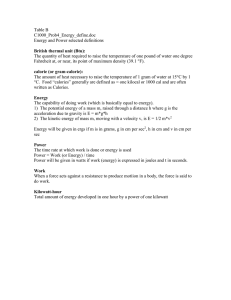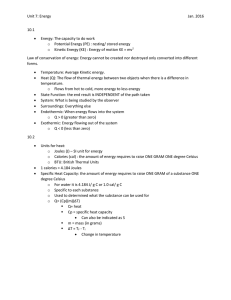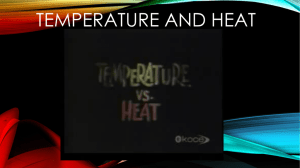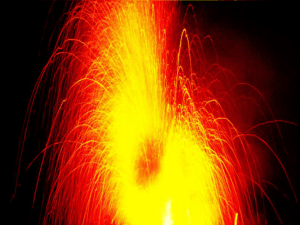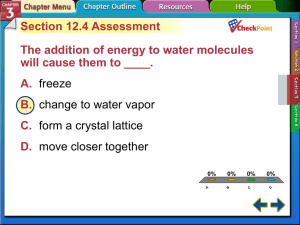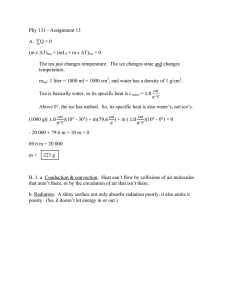Specific Heat Capacity: Definition, Calculations & Examples
advertisement
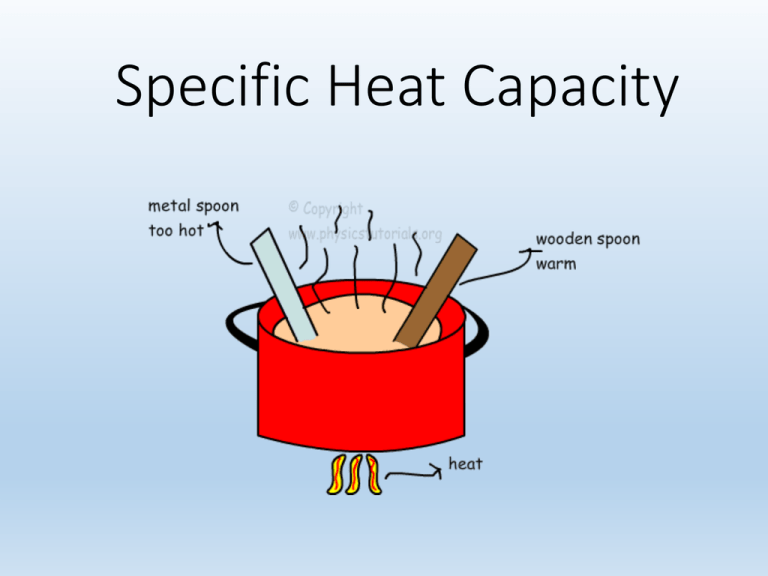
Specific Heat Capacity Specific Heat Capacity • The amount of energy it takes to heat up 1 gram of a substance by 1°C • What heats up faster, metal or water? Calorie • Energy changes can also be measured in calories. • One calorie is defined as the amount of energy needed to increase the temperature of one gram of water by one °C. • 1 calorie = 4.184 joules Can Drinking Ice Water Help You Lose Weight? • You drank 1 liter (1000 grams) of water at 0°C and in your body it rose to a temperature of 37°C. • That would result in the conversion of 37,000 calories of heat from the body to the water. • Sound like a great way to lose weight doesn’t it? Water is 1 cal = 1 g / 1°C Big C vs. little c • A calorie is a tiny unit of measurement. • For food, what they call a calorie is really a kilocalorie or 1000 calories. • So, in order to differentiate them, a food calorie is a capital C and an energy calorie is little c. Can Drinking Ice Water Help You Lose Weight? • 37,000 calories of heat from the body to the water sounds great! • But, don’t forget that 1 food calorie is actually a kilocarlorie which is equal to 1000 calories. So, that means drinking that water really burns 37 Calories, which is tiny compared to the more than 3000 Calories we eat every day. Specific Heat Capacity • The amount of energy required to raise the temperature of one gram of a substance by one Kelvin unit. • Units: joule per gram Kelvin = J/g•K • Remember, 1 K = 1 °C Substance Specific Heat Substance J/gm K Acetone 1.47 Aluminum 0.90 Acetylene 1.69 Bismuth 0.12 Air 1.01 Copper 0.39 Ethanol 1.88 Brass 0.38 Ammonia 2.19 Gold 0.13 Argon 0.52 Lead 0.13 Benzene 1.09 Silver 0.23 Bromine 0.25 Tungsten 0.13 Butane 1.67 Zinc 0.39 Carbon dioxide 0.84 Mercury 0.14 Carbon monoxide 1.02 Oxygen gas 0.92 Chlorine 0.48 Carbon disulfide 0.67 Ethane 1.75 Gasoline 2.22 Ethylene 1.53 Calcium Chloride 3.06 Helium 5.19 Sodium chloride 3.31 Hydrogen 14.32 Ammonia 4.60 Natural Gas 2.34 Ethylene glycol 2.42 Neon 1.03 Silicone Oil 1.80 Nitric Oxide 1.00 Freon 1.51 Nitrogen 1.04 Sea Water 3.93 Nitrogen tetroxide 4.69 Water Vapor 1.93 Oxygen 0.92 Water 4.19 Propane 1.67 Ice (-10 C) 2.05 Sulfur dioxide 0.64 Granite 0.79 Xenon 0.16 Glass 0.84 Specific Heat Capacity of iron is 0.45 J/g*°C • How many joules will it take to heat a 100 gram frying pan of iron from 20°C to 150°C? Q = Heat • Q = s • m • ΔT • Q = joules • s = specific heat capacity • m = mass of sample (g) • ΔT = change in temperature (°C) Specific Heat Capacity of iron is 0.45 J/g*°C • How many joules will it take to heat a 100 gram frying pan of iron from 20°C to 150°C? • Joules = 0.45 J/g*°C * 100g * 130°C • 5850 grams Why are there often plastic handles on frying pans? • Plastic has a higher heat capacity, so it takes much more energy to heat it up than the metal, thus you avoid burning your hands. Energy Released As Heat • energy as heat absorbed by the solution = • specific heat capacity (s) times • mass of the solution (g) times • increase in temperature (K) J • g • K = Joules of energy g•K Example Problem #1 • A 1.6 gram sample of goldish-colored metal requires 5.8 J of energy to change it’s temperature from 23°C to 41°C. Is this metal gold? • Q = s • m •ΔT • 5.8 J = s • 1.6 g • 18°C • s = 0.20 J/g°C • Gold has a specific heat capacity of 0.13 J/g°C, so it is not gold. Enthalpy: ΔH • Refers to changes in energy state. • Energy can be released as heat or work • ΔH = Hfinal − Hinitial • ΔH is the change in enthalpy of the system and Q is the energy added to the system through heat. Latent Heat • Latent heat is the heat released or absorbed by a body during a change of state without a change of temperature. • The term most often refers to a phase transition such as the melting of ice or the boiling of water Latent Heat of Fusion • The heat required to change one mole of a substance from a solid to a liquid. • It is a latent heat, as it is added to break the bonds of the crystalline structure, and yet does not change the temperature. Latent Heat of Vaporization • The heat required to change a mole of a substance from a liquid to a gas. • It is also a latent heat, as it is added to disrupt the intermolecular attraction the liquid molecules have to each other so they can be free to leave as a gas. • But, the temperature does not change. That is why boiling water does not get any hotter than 100°C (or 92°C in Flagstaff) QS + Hf + QL + Hv + Qg = QT Calorimetry • A calorimeter is a device used to measure heat of reaction • If you do a chemical reaction or a want to determine the heat of solvation, heat of fusion, or others, it can be measured in a calorimeter. Q = mwater•Cwater•ΔTwater Cwater is 4.18 J/g/°C Calorimetry • For instance, if you want to measure the heat of fusion for water, you can measure the mass of an ice cube and then place it into water in a calorimeter and see how much the temperature changes. Q = mwater•Cwater•ΔTwater Cwater is 4.18 J/g/°C
